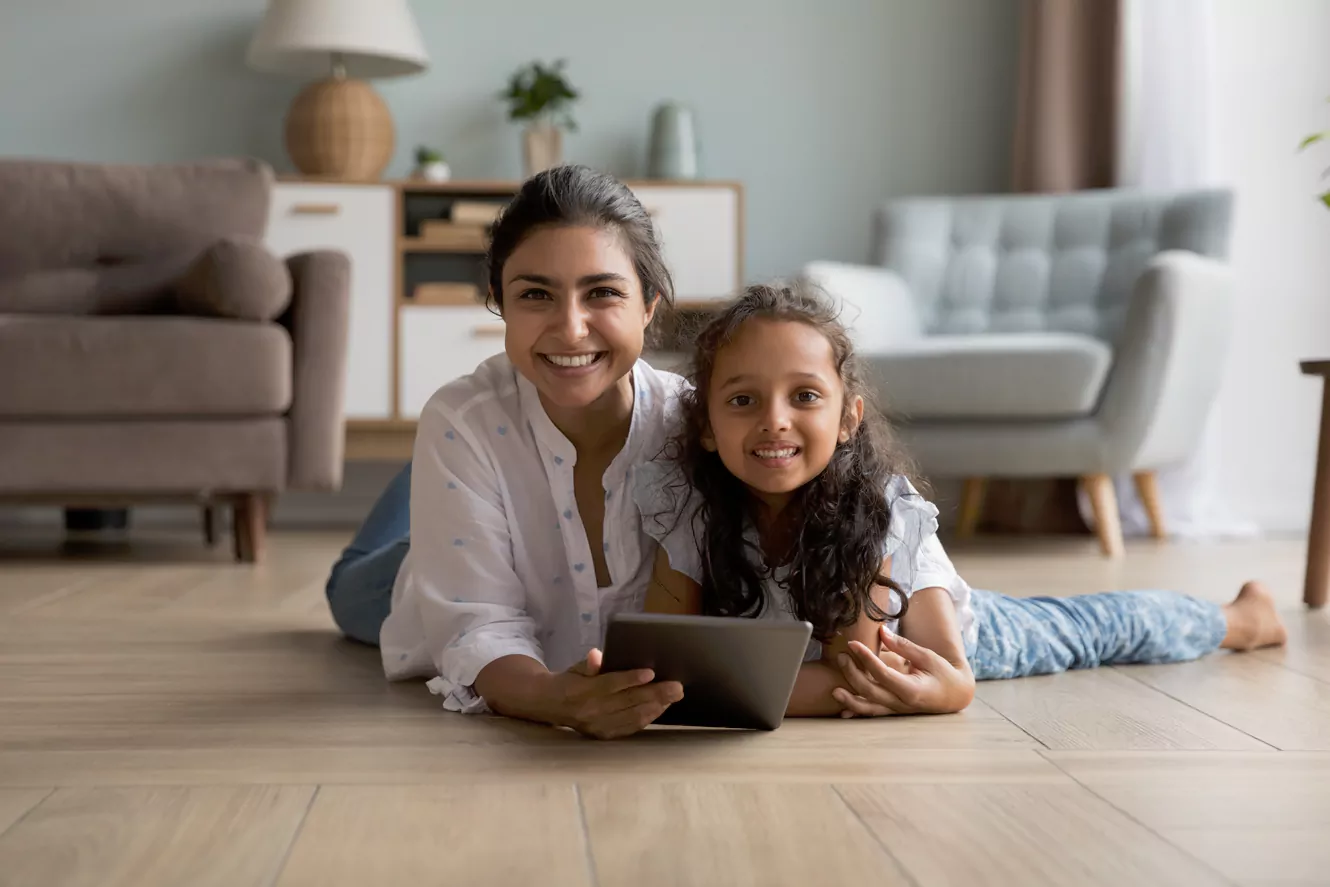Digital Parenting
— Why Be Left Out When You Can Be Right In?
Digital technology has become an integral part of our daily lives, including the lives of our children. While technology can bring many benefits to children’s education and development, it is important to also consider how it can disrupt and disrupt their well-being.
Digital parenting refers to the ways in which you as a parent can guide and support your children’s use of technology and the internet. Being “right in” means being actively involved in and aware of your children’s online activities, rather than being left out or unaware of what they are doing online.
But first, let’s together explore the potential positive and negative effects of digital technology on the well-being of children and discuss how being a ‘Present Parent’ can help mitigate most of the potential negative impacts.
Overall, being a digital parent means taking an active role in your children’s online lives, and helping them learn to use technology in a responsible way. Keeping children safe and helping them browse and can embark upon their own individual healthy online journeys.
Benefits of being present in your child’s digital life

So let’s begin with the several benefits of getting involved and how you will be able to help your child by being an informed digital parent:
1) You can help your children develop healthy habits around technology use. This includes setting limits on screen time, encouraging a balance of online and offline activities, and helping your children learn to use technology responsibly.
2) You can keep your children safe online. This includes monitoring their online activities, helping them understand online safety rules, and teaching them how to recognize and avoid potential online dangers.
3) By being involved in your children’s online activities, you can stay up-to-date on what they are doing and learning online, and you can support and guide their learning and development. Hence, it pays to stay connected to your children and support the online learning.
Navigating the online world

Digital parenting refers to the way parents can support and protect children and adolescents as they navigate the online world. This has now become an increasingly important task for parents as technology plays a central role in many young people’s lives, and the internet offers both opportunities and exposes them to plenty of risks.
One of the first things that parents need to think about when it comes to digital parenting is setting boundaries and limits around screen time. This can be challenging, as technology is a powerful asset as well as a great distraction for younger children.
It is also important to have open and honest conversations with your child about their technology use and to explain why certain rules are in place. This might include creating designated times for technology use, and specifying which websites and apps are appropriate for their use.
First and foremost, it is important to recognize the impact computer screens have on children’s sleep. The blue light emitted by these screens interferes with the production of the sleep hormone melatonin, leading to difficulty falling asleep and poor sleep quality. This can have negative impacts on children’s physical and mental health, including an increased risk of obesity, diabetes, and depression.
One way to discourage excessive time spent on screens is by setting time limits and establishing designated times for research online. For example, you could permit the use of technology only after homework is completed or keep it for the weekends.
It is also helpful to establish screen-free zones within the premises of a home, such as a bedroom and washrooms, to encourage children to disconnect from technology and engage in conversing with other members of the family.
It is also important for parents to model healthy technology use themselves and to communicate with their children about the appropriate use of technology. This can include discussing online safety and the importance of protecting personal data.
Ensuring safety when online

One of the most important aspects of digital parenting is teaching children how to be safe when online. This includes things like not sharing personal information, not deciding to physically meet up with people they have only met online, and being aware of cyberbullying. It is also important for you as parents to be aware of the websites and apps that your children are visiting and to ensure that these are age-appropriate.
In addition to setting boundaries and teaching online safety, it is very important for parents to model good technology behaviours and habits for their children by setting an example. Remember, children learn by example and copy what adults do. This means being mindful of your own technology use and being present when interacting with your child rather than being seen constantly on your phone or computer.
Set clear ground rules and expectations around when and how technology can be used, and enforce these rules consistently.
Some suggestions for setting limits on screen time include:
- Establishing a daily or weekly screen time quota, and help children to stick to it
- Setting specific times of day when technology is not allowed, such as during homework, mealtime, or bedtime
- Make sure that children have plenty of other activities and hobbies to engage in, so they are not reliant on screens for entertainment. Involving them in regular physical activities is not only a great idea but also essential for their overall health and well-being.
Educate your children about the potential risks of the internet, such as online predators, cyberbullying, and exposure to inappropriate content, and help them to understand how they need to protect themselves.
Encourage children to think before they share personal information online, and to be cautious about accepting friend requests or messages from strangers. Remember to teach your children to use privacy settings on social media and other online platforms.
When and if breaking these rules becomes endemic, set up parental controls and monitoring tools to help filter out inappropriate content and block unwanted sites and contacts.
Digital technology can bring many benefits to children’s education and development, but it is important to consider the potential negative impacts on their well-being. By setting clear boundaries and limits, educating children about online safety, and modelling healthy technology use, parents can help to ensure that children use digital technology in a way that is positive and beneficial to them.
Helping your child develop critical thinking skills

Critical thinking is the ability to analyse and reflect upon what to do before reacting. This is an invaluable skill for parents and children alike. Technology and the internet can be assessed and used positively to help develop skills and knowledge, connect to others, or for entertainment. But like all good things, technology and the internet are open to abuse posing risks to young children’s health, safety, privacy and exposure to possible harmful influences.
This is why thinking critically is important as it can ensure the safe and healthy online development of children. It is an essential skill that parents can pass along to their children through leading by example. It also helps children develop the skill of thinking for themselves and making informed decisions, as well as understanding and solving problems, and communicating their ideas with clarity and effectiveness.
One of the biggest challenges of digital parenting is helping your child strike a balance between the benefits and risks of technology overuse. The Internet suffers from a proliferation of fake news and other forms of misinformation. This is why it is more important than ever for children to be able to evaluate the credibility and reliability of the sources that they encounter online.
Here are some ways parents can help children sift:
- Encourage children to ask questions and seek out multiple sources of information
- Teach children how to evaluate the credibility of websites and other online sources
- Help children to understand the importance of fact-checking and to be skeptical about sensational headlines or claims
- Discuss current events and news stories with children, and help them to think critically about the information that they are presented with
Engage in conversations & share ideas

Along with learning and acquiring critical thinking skills, it is also important that your children feel comfortable coming to speak to you when and if anything goes wrong, or when they are just confused about something they found on the net. These are indispensable tools that children can apply to many different situations throughout their lives as well.
It is also necessary for parents to continue to have these conversations regularly, even when the subject matter is uncomfortable. Regular family conversations lead to an exchange of ideas and understanding.
Parents and family members who have regular, open conversations are able to learn about each other and learn from each other. Continuing the conversation with your children on online issues and topics allows the digital parenting relationship to build and strengthen.
Your children should know that they can rely on you for support, for listening, and for exchanging viewpoints and opinions. You may use any kind of informal family time (in the car, while cleaning up, prepping for dinner or just taking a walk) to engage in conversations about your child’s online world experiences.
It is better to be safe than sorry

The number of children and the number of ways they connect on social media platforms is unprecedented. At no point in human history, have so many young children had the capability to connect so instantly and so intimately with others.
Users share videos, images, and other creative content. Users make connections with others over shared interests, values and ideals, participate in interactive dialogues and enhance friendships and relationships.
These are some of the ways social media is playing a vital role in children’s social and creative lives and can be a positive extension of their face-to-face interactions. However, never forget that social media sites can also pose extreme risks to children, such as oversharing, seeing or sharing inappropriate images, cyberbullying, sexting and more.
Parents need to guide their children in the responsible use of social media so that they learn how to recognise and navigate the risks and how they want to be treated and treat others online.
Steps to take to ensure positive exposure:
- Check to see if the social media platform is appropriate for your child
- Avoid putting in place restrictions arbitrarily. Guide your child in being selective in the usage instead.
- Keep an eye on privacy and location settings to make sure that personal images and videos are not easy to access
- Make sure your child understands that the people she meets online cannot be trusted. They are not real-life friends.
- Tell your children not to share personal data that can expose them.
- Open an account on the same social media platform and play the role of the friend your child is looking for.
- Make sure that your child has other trusted adults to speak to (e.g. a relative or teacher) in the event that she does not want to share with you.
- Perform regular name searches to authenticate the online content and is from a verifiable source.
While these are more general social media strategies to adopt, there are also specific things that parents can do to support their children’s social media usage depending on their age and interests.
For young children, this might include finding educational apps and games that align with their interests and developmental level. For older children and teenagers, this might involve helping them to find and use technology for research and studying or encouraging them to use technology for creative pursuits such as music or art, practising strokes, and learning how to apply strategic thinking to a game of tennis or squash.
Ultimately, the most effective approach to digital parenting is one that is tailored to the specific needs and interests of each child. By setting boundaries, teaching online safety, modelling good technology habits and behaviours, and helping children to develop critical thinking skills, parents can help their children to use technology in a way that is safe, responsible, and enriching.
About My Gym & Abrakadoodle
My Gym aims to lay a firm foundation for personal, academic and future growth by involving your child in age-appropriate, structured and unstructured physical activities. Helping strengthen neural networks within the brain and developing a child’s thinking and problem-solving skills.
At Abrakadoodle, process art learning experiences inspire toddlers and young children to help articulate their thoughts and feelings. Children also discover visual art is the easiest way to relax and meditate. Doodling, scribbling, painting and drawing help children to think differently, be innovative, and explore new ways to grow their minds.



